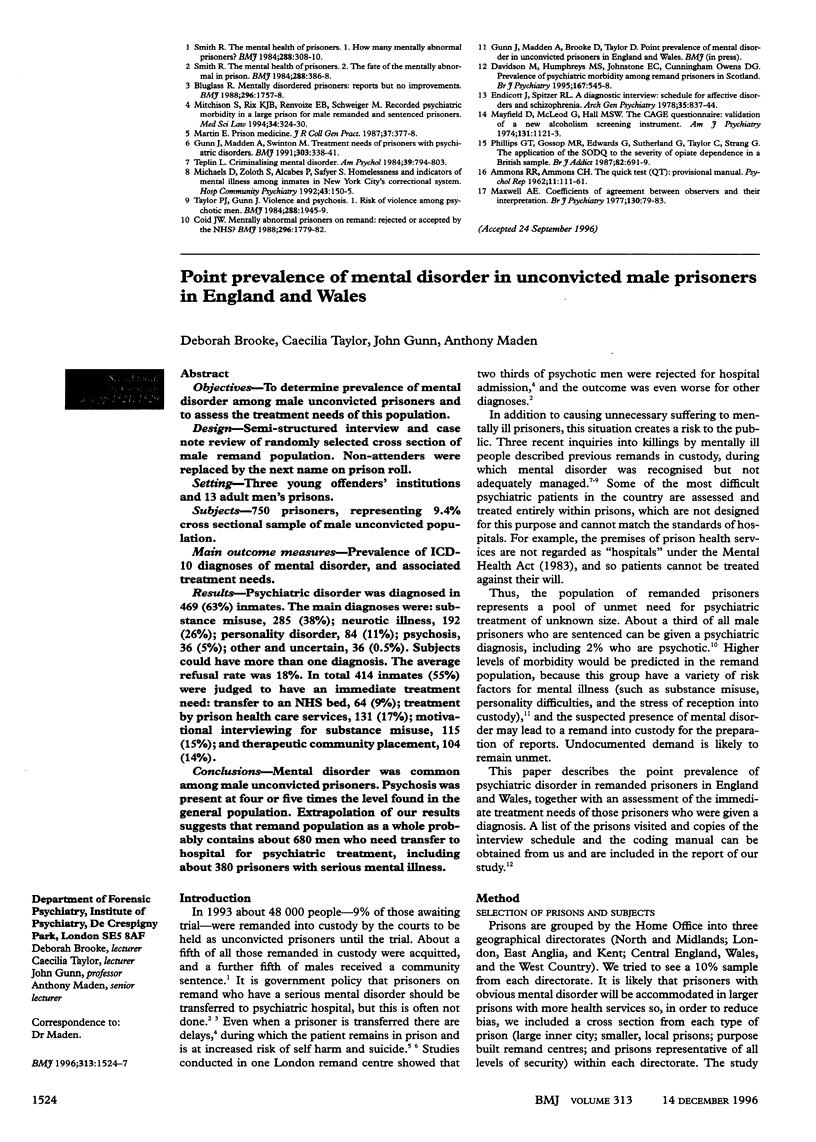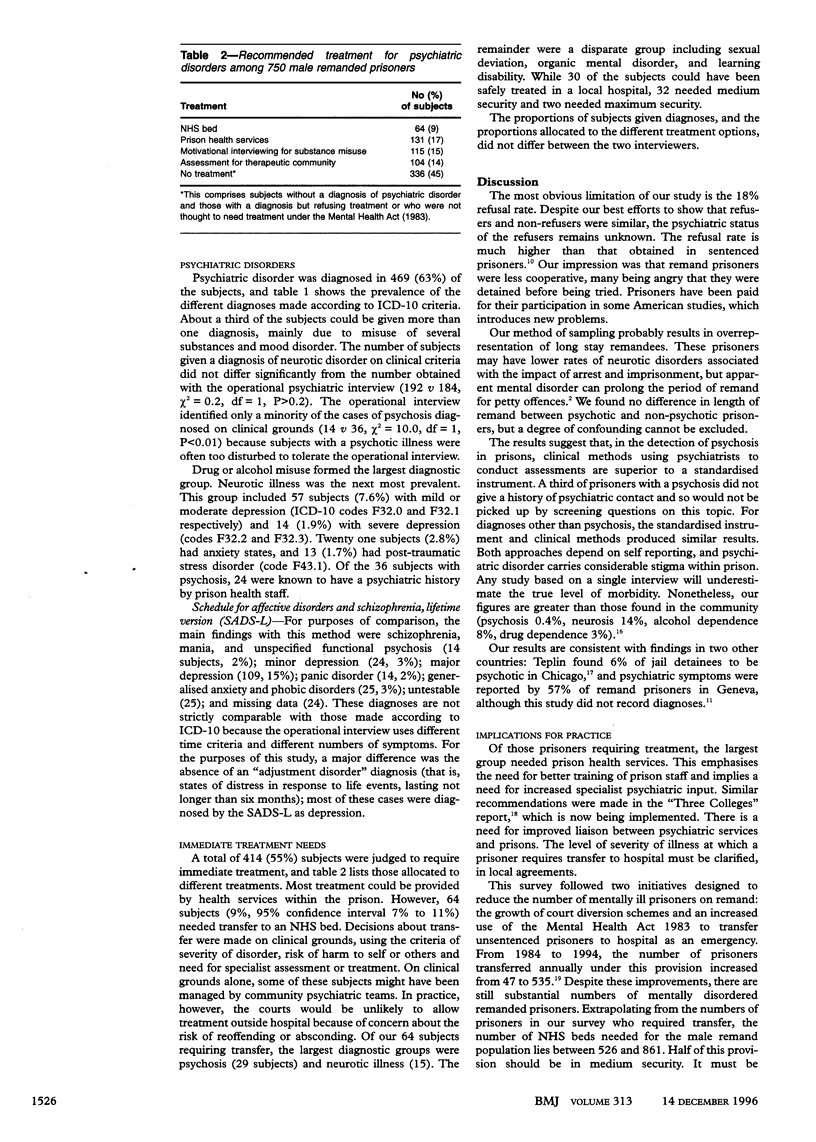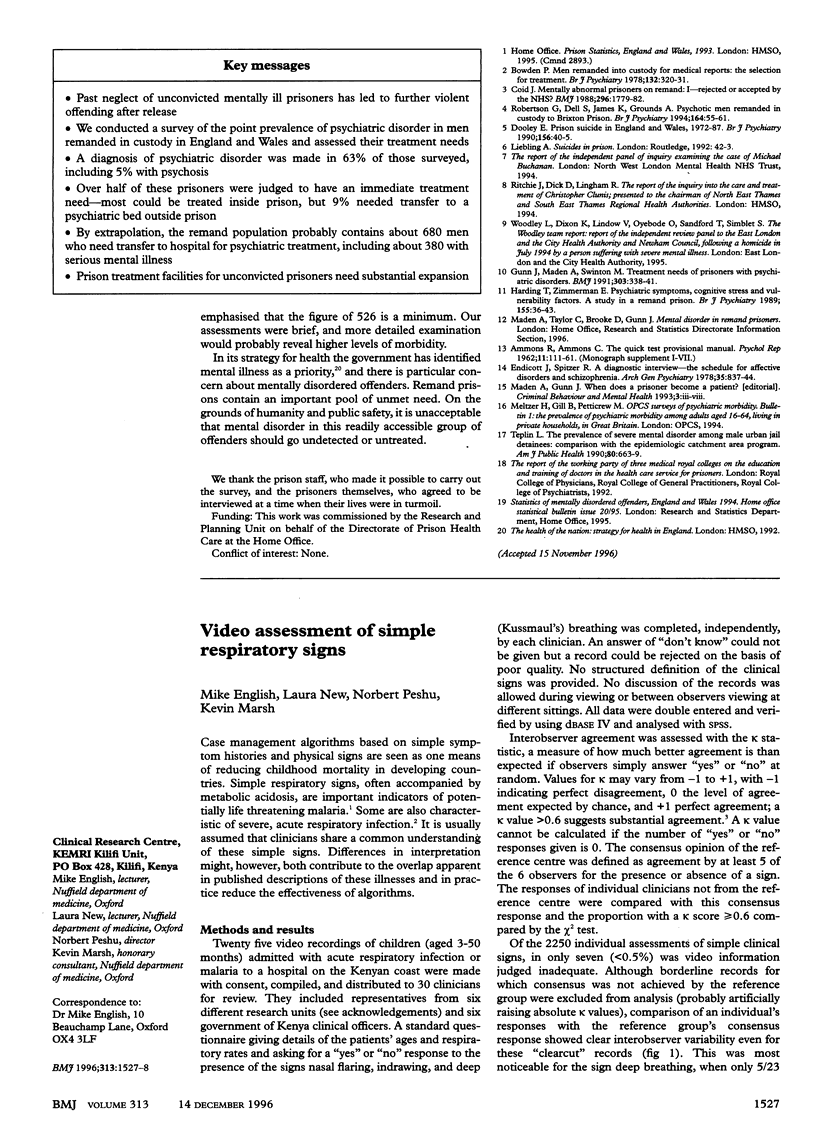Abstract
OBJECTIVES: To determine prevalence of mental disorder among male unconvicted prisoners and to assess the treatment needs of this population. DESIGN: Semi-structured interview and case note review of randomly selected cross section of male remand population. Non-attenders were replaced by the next name on prison roll. SETTING: Three young offenders' institutions and 13 adult men's prisons. SUBJECTS: 750 prisoners, representing 9.4% cross sectional sample of male unconvicted population. MAIN OUTCOME MEASURES: Prevalence of ICD-10 diagnoses of mental disorder, and associated treatment needs. RESULTS: Psychiatric disorder was diagnosed in 469 (63%) inmates. The main diagnoses were: substance misuse, 285 (38%); neurotic illness, 192 (26%); personality disorder, 84 (11%); psychosis, 36 (5%); other and uncertain, 36 (0.5%). Subjects could have more than one diagnosis. The average refusal rate was 18%. In total 414 inmates (55%) were judged to have an immediate treatment need: transfer to an NHS bed, 64 (9%); treatment by prison health care services, 131 (17%); motivational interviewing for substance misuse, 115 (15%); and therapeutic community placement, 104 (14%). CONCLUSIONS: Mental disorder was common among male unconvicted prisoners. Psychosis was present at four or five times the level found in the general population. Extrapolation of our results suggests that remand population as a whole probably contains about 680 men who need transfer to hospital for psychiatric treatment, including about 380 prisoners with serious mental illness.
Full text
PDF



Selected References
These references are in PubMed. This may not be the complete list of references from this article.
- Bowden P. Men remanded into custody for medical reports: the selection for treatment. Br J Psychiatry. 1978 Oct;133:320–331. doi: 10.1192/bjp.133.4.320. [DOI] [PubMed] [Google Scholar]
- Coid J. W. Mentally abnormal prisoners on remand: I--Rejected or accepted by the NHS? Br Med J (Clin Res Ed) 1988 Jun 25;296(6639):1779–1782. doi: 10.1136/bmj.296.6639.1779. [DOI] [PMC free article] [PubMed] [Google Scholar]
- Dooley E. Prison suicide in England and Wales, 1972-87. Br J Psychiatry. 1990 Jan;156:40–45. doi: 10.1192/bjp.156.1.40. [DOI] [PubMed] [Google Scholar]
- Endicott J., Spitzer R. L. A diagnostic interview: the schedule for affective disorders and schizophrenia. Arch Gen Psychiatry. 1978 Jul;35(7):837–844. doi: 10.1001/archpsyc.1978.01770310043002. [DOI] [PubMed] [Google Scholar]
- Gunn J., Maden A., Swinton M. Treatment needs of prisoners with psychiatric disorders. BMJ. 1991 Aug 10;303(6798):338–341. doi: 10.1136/bmj.303.6798.338. [DOI] [PMC free article] [PubMed] [Google Scholar]
- Harding T., Zimmermann E. Psychiatric symptoms, cognitive stress and vulnerability factors. A study in a remand prison. Br J Psychiatry. 1989 Jul;155:36–43. doi: 10.1192/bjp.155.1.36. [DOI] [PubMed] [Google Scholar]
- Robertson G., Dell S., James K., Grounds A. Psychotic men remanded in custody to Brixton Prison. Br J Psychiatry. 1994 Jan;164(1):55–61. doi: 10.1192/bjp.164.1.55. [DOI] [PubMed] [Google Scholar]
- Teplin L. A. The prevalence of severe mental disorder among male urban jail detainees: comparison with the Epidemiologic Catchment Area Program. Am J Public Health. 1990 Jun;80(6):663–669. doi: 10.2105/ajph.80.6.663. [DOI] [PMC free article] [PubMed] [Google Scholar]


